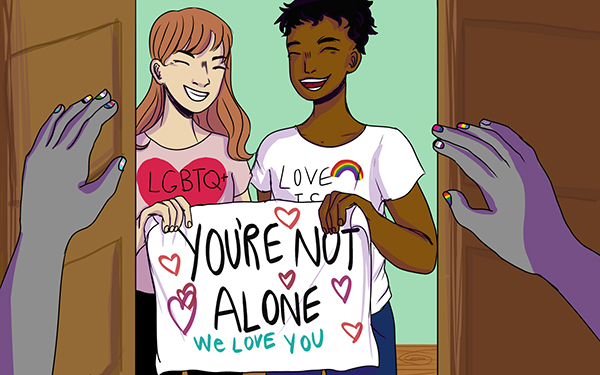LGBTQ+ students face obstacles, fight for acceptance

December 14, 2018
Sunday June 28, 2015: hoards of people across the U.S flooded the streets adorned in rainbows in celebration of a monumental step in the fight for gay rights—the legalization of same-sex marriage in all 50 states two days earlier, according to The Washington Post. Three years later, millions are still fighting persecution that the LGBTQ+ community faces globally.
According to a Gallup poll from 2017, 4.5 percent of American adults identify as gay, lesbian, bisexual or transgender. However, according to a Human Rights Campaign survey of more than 10,000 LGBTQ+ youth ages 13-17, 42 percent said that the community in which they live is not accepting of LGBTQ+ people.
Heather Chambers, Sexuality and Gender Alliance (SAGA) club co-sponsor, says that although LGBTQ+ youth face the same problems as all young people, their experiences with these issues are often different.
“All teenagers stress about where they fit in, they stress about their identity, they worry about their grades, being involved, extracurriculars, sports, academics,” Chambers said. “[LGBTQ+ teenagers’] added worry is that they may…feel that part of their identity makes them different, against the norm, and [they question if] people [are] going to judge them for that.”
Matthew Bertke, SAGA club co-sponsor, says that LGBTQ+ youth oftentimes have to bear the secret of knowing that they are different from the norm.
“Straight cisgendered is the expectation, and so first realizing that you’re different, and that burden of knowing you have a secret, and then the worry about how people are going to react to who you are, really causes the difference [between LGBTQ+ and straight kids],” Bertke said.
Sophomore Jeremey Osbourne* is transgender and gay, and says that he first knew he was trans at a young age.
“[Sexuality and gender weren’t] things that were talked about in my family,” Osbourne said. “When I was little I was always taking my brother’s clothes, and I was that tomboy kind of a kid, which my parents were fine with, until they realized that it didn’t look like I was going to grow out of it.”
Junior Hayley Manning, who identifies as lesbian, advises people who are questioning their sexuality to not feel rushed to put themselves in a certain category or come out to others.
“If you’re questioning [your sexuality] or you think you might be something and you’re questioning it, don’t rush to put a label on it,” Manning said. “You shouldn’t feel pressured to label yourself as something you’re you end up. Just make yourself happy. It’s really great if you get to come out at your own pace.”
Osbourne says that since the beginning of his freshman year, he began to come out to his family and friends. He believes that coming out is difficult for LGBTQ+ youth for fear of rejection. He made the choice to come out because of discomfort from being misgendered, according to Osbourne.
“Being in the closet is kind of a painful thing, especi ally as a trans person, because I was walking through life and every time someone was using a name that I wasn’t comfortable with or the wrong pronouns or I was put in a situation where it was ‘girls and boys’ and I had to go on the girls’ side, or even using the women’s restroom, I was so, so uncomfortable, that eventually I just couldn’t do it anymore,” Osbourne said. “I needed to come out and face what was going on.”
Senior Cameron Hughes*, who is gay and nonbinary and currently uses any pronouns, says that as they grew up, they came to know that they were nonbinary after exposure to the LGBTQ+ community in high school. Hughes says that while people at South are generally accepting, they still hear derogatory terms and slurs used by students. They also believe that there is more acceptance for sexuality than there is for gender identity.
“I think education is important, and I think maybe having stricter rules [could help] because teachers [will say] ‘Please don’t swear in my class’, but then I hear people say these slurs in front of teachers and they don’t do anything about it,” Hughes said.
Osbourne believes that education needs to be used to eliminate the use of some derogatory words among the student body, and that people need to understand the implications of their language choice. He also says that more LGBTQ+-friendly education can be implemented in Health classes and history classes.
“I think that there is a culture that certain words are acceptable to be used, like the f-slur, or things like ‘that’s so gay’, and while people don’t always realize it, those things cut deep,” Osbourne said. “I think this school needs to be educated more.”
Chambers believes that teachers are generally very inclusive, and that there are several policies and accomodations in place to support LGBTQ+ youth.
“I think GBS does a great job with keeping teachers educated about issues that are relevant or important to the LGBTQ+ community,” Chambers said. “Having the gender neutral bathrooms [and] having policies in place through the school board [helps] kids, [though]. There’s always room for growth and acceptance.”
While Osbourne believes that GBS is quite accepting, he says that South and other schools can take further steps to improve their environments to support LGBTQ+ youth in the face of problems such as parental rejection.
“The suicide rate for LGBTQ+ youth is so much higher,” Osbourne said. “South is doing a pretty good job of [supporting LGBTQ+ students] that but there’s always more we can be do. There’s always students who are struggling.”
*Names have been changed


